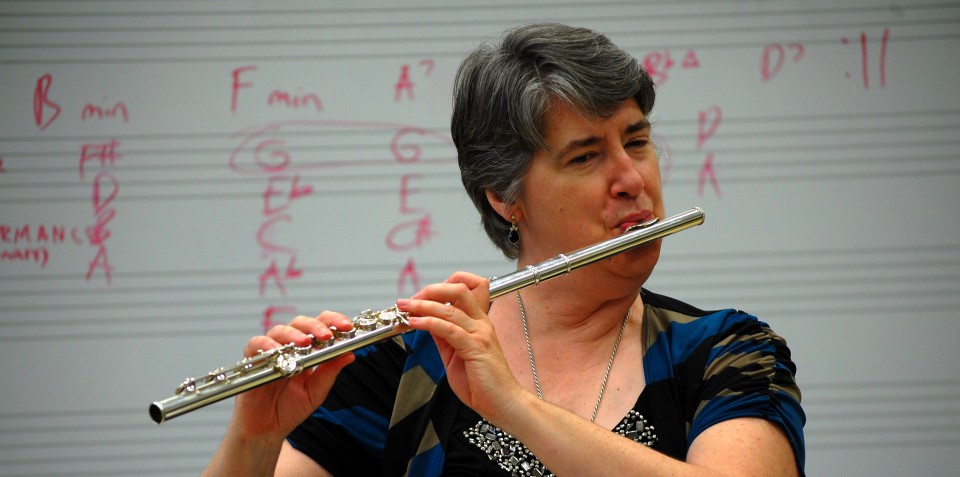Tags
embouchure, flute balance, flute embouchure, flute fingering, flute intonation, flute pedagogy, flute students, flute technique
The third octave on the flute is an interesting phenomenon because of the embouchure issues it presents and because of the technical and acoustic properties of the instrument. It is definitely not as straight forward as the lower two octaves in terms of the mechanics of the flute. The reason for all the cross fingerings and venting in the third octave is because each note is combining the harmonics of two lower pitches to reinforce the sound of each note. One of the easiest to conceptualize is the fingering for high E: T12|12(Eb) It is combining the overtone series of both E and A. In fact, if the air speed is insufficient, an out of tune A will sound below the intended pitch with this fingering. You can get to the high E by playing harmonics on either E or A. For E it will be the 4th partial and for A it will be the 3rd partial. The two combined make the standard fingering for third octave E (among flutists it is generally agreed that the E is better in tune without the Eb key).
Be sure your flute students know the third octave fingerings. It isn’t enough for them to just overblow a 1st/2nd octave fingering. They will be playing harmonics rather than the correct third octave fingering. The real fingerings will always sound more solid and will be easier to play in tune. Give them a way to practice these fingerings and test them on the practicing you assign. The kids need concrete ways to build their facility in the third octave. Here is one way to practice third octave technique.
 Then there are the common embouchure issues you see with kids. It is common for students to struggle with buzzing rather than playing the desired pitch in the third octave. What causes the buzzing? Their lips are stretched laterally, from corner to corner. If your kids are pulling their corners, there is a really high probability that they will buzz in the third octave. Have them pay more attention to how they are shaping the aperture in the middle of their lips (like how your lips are shaped to blow a kiss or to drink through a straw), and forget about the corners. Remember to blow!
Then there are the common embouchure issues you see with kids. It is common for students to struggle with buzzing rather than playing the desired pitch in the third octave. What causes the buzzing? Their lips are stretched laterally, from corner to corner. If your kids are pulling their corners, there is a really high probability that they will buzz in the third octave. Have them pay more attention to how they are shaping the aperture in the middle of their lips (like how your lips are shaped to blow a kiss or to drink through a straw), and forget about the corners. Remember to blow!
Another common problem is trying to control the third octave by flattening the aperture, rolling the flute in and pinching. Usually what goes with this is insufficient blowing. Oh no! High notes! Cue the Psycho shower scene music! The results are going to be really sharp and likely unsuccessful beyond high E or F. They will be lucky to get to a G. You have to help unwind them. Flute lower on the chin, roll the flute out a bit, relax the corners, shape the aperture (think of saying “W”) and blow more. Make sure the flute is aligned properly, check hand positions and balance. It seems paradoxical that rolling the flute away from you a little bit would improve the response and intonation of the high notes, but it works like magic. Check out this device (Flute Tutor) that can help enforce this positioning with your students.
 If you find these entries useful, please subscribe, share with your colleagues and come back regularly for more flute tips. Feel free to comment. If you have a topic you would like to see explored more fully, you can contact me via IM/Messenger on Facebook or email me at dr_cate@sbcglobal.net. For information about clinics, workshops and performances, click here.
If you find these entries useful, please subscribe, share with your colleagues and come back regularly for more flute tips. Feel free to comment. If you have a topic you would like to see explored more fully, you can contact me via IM/Messenger on Facebook or email me at dr_cate@sbcglobal.net. For information about clinics, workshops and performances, click here.

Pingback: Top 10 Posts of 2016 on Dr. Cate’s Flute Tips | Dr. Cate's Flute Tips
Pingback: Favorite blog posts, April 2016 | Bret Pimentel, woodwinds